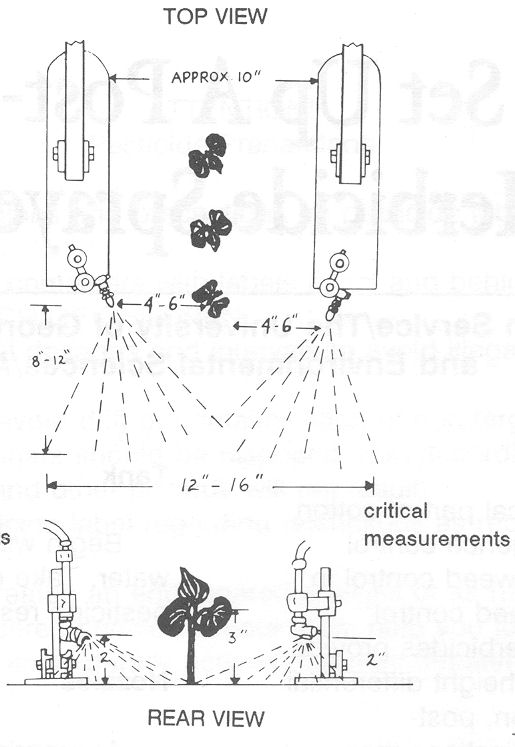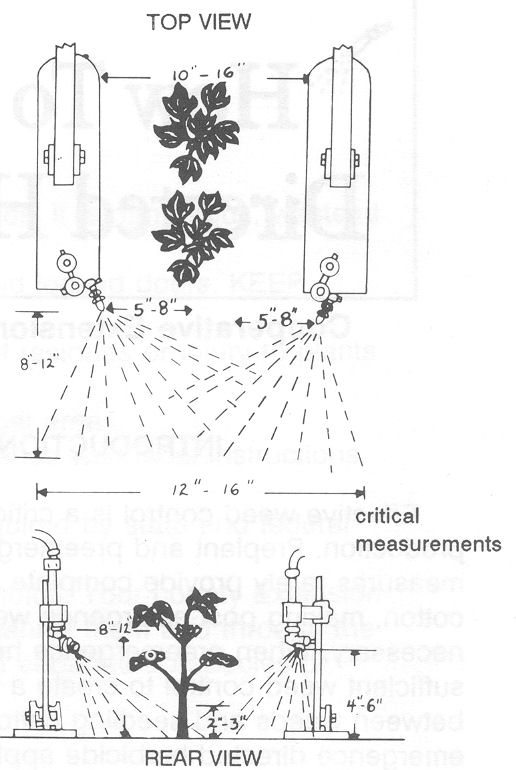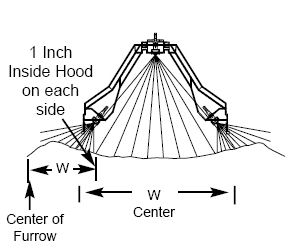INTRODUCTION
Managing weeds, especially Palmer amaranth, in cotton has become one of the greatest challenges facing cotton production. Herbicides applied at planting or topically to small cotton do not provide season-long weed control; however, they often do provide sufficient weed control to create a height difference between weeds and cotton. This height difference is enough to successfully apply post-emergence directed herbicides during mid- and late-season.
Even with today's technology, it is critical that growers use directed herbicides in their cotton crop to improve coverage of weeds hiding under the cotton canopy. Most importantly, growers should rotate herbicide chemistry to reduce additional selection pressure on glyphosate and acetolactate synthase (ALS) herbicides. Precision applications maximizing spray coverage of weeds and minimizing spray contact with cotton, which can cause injury, is critical. Spray fender/cultivator and shield/hood sprayers are commonly used for precision, directed-spray applications.
FIELD CONDITIONS
A smooth, flat-row profile is ideal for precise, post-directed herbicide application equipment. Shielded or hooded sprayers can operate in rougher conditions, but uniform application height is still desirable. When conditions are less than favorable, reducing the rate of speed may be an effective way to reduce the potential for increased herbicide injury.
COTTON
Cotton height and stem “barkiness” are the two most critical factors when choosing an herbicide. Most directed herbicides have cotton height requirements and should only be applied after cotton exceeds the minimum height requirement. Several herbicides, including Valor, Aim and ET, also suggest the need for barky cotton in addition a minimum 18-in. height requirement because a barky stem reduces the amount of stem necrosis and potential lodging. Contact your county UGA Extension office and refer to the latest Georgia Pest Management Handbook for labeled herbicide options and suggested application rates and procedures.
EQUIPMENT
Tank
Begin with a clean spray tank filled with clean water. Clean the tank carefully to remove any pesticide residues.
Nozzles
Appropriate spray nozzle tips include off-center or flat fan tips (extended-range, air-injected, anti-drift, lo-drift, etc). Screens should be 50-mesh. Sprayers should be operated at low pressure, in the range of 20 psi, to prevent fogging or misting the spray pattern. Spray volume should be adequate for complete weed coverage, usually at least 20 gpa on a broadcast basis.
Inspect spray tips and screens to be sure they are the same size. Check nozzle output uniformity across the sprayer by collecting spray volume from each nozzle for 1 min at 20 psi. Replace nozzles that deviate more than 10% from the average collected. Repeat the process with any replaced nozzles.
Directed Spraying
Adjust nozzles so the spray pattern of the two nozzles on each row:
- contacts cotton 1 in. up the stem (up to 2 in. on larger cotton);
- avoids, or at least minimizes, contact with cotton leaves;
- overlaps a few inches on each side of the cotton drill*;
- extends outward to cover the "shoulder" or the area just outside the spray fender; and
- reaches the soil surface about 8 to 12 in. behind the nozzle (see Figures 1 and 2).
Adjust each nozzle for fine-tuned, precise application.
* Precise directed herbicide application on rough, uneven surfaces is difficult. Under such conditions, minimize spray overlap and contact with young cotton stems. Aim spray patterns to the base of the stems to reduce the potential for excessive coverage and cotton injury (Figure 3).
 Figure 1. Adjust sprayer nozzles.
Figure 1. Adjust sprayer nozzles. Figure 2. Properly adjust sprayer nozzles.
Figure 2. Properly adjust sprayer nozzles. Figure 3. Aim spray patterns to the base of the stems to reduce the potential for excessive coverage and cotton injury.
Figure 3. Aim spray patterns to the base of the stems to reduce the potential for excessive coverage and cotton injury.
Shielded and Hooded Sprayers
To reduce drift and injury, use shielded or hooded sprayers for in-crop, post-directed herbicide application. Note: The shield or hood alone is not enough to provide cotton safety when applying herbicides in unfavorable weather conditions or on difficult terrain. Abide by normal recommendations for applying herbicides in a manner to reduce drift. Select a nozzle that will produce as large a drop as practical for coverage, spray volume and control. Use lower pressure, extended range (15 to 20 psi) nozzles instead of more conventional nozzles (40 psi) to reduce fine spray production. One, two, or three nozzles spraying the area shielded by the hood can be used; however, three nozzles are encouraged.
Normally the largest droplet size will be obtained by using one nozzle in the center of the hood (Figure 4), but a single nozzle may provide less coverage of larger weeds. Set the hood and the nozzles for the lowest position to adequately cover the weeds to be controlled. As in any post-directed spraying, angling the nozzles to the rear will usually give better coverage at a lower height. Never allow a nozzle to spray against the shield or curtain to accumulate and run off.
 Figure 4. A single and three-nozzle set-up for hood spraying.
Figure 4. A single and three-nozzle set-up for hood spraying.
DUAL CHEMICAL APPLICATION
In this configuration there are two plumbing systems—one for the center hood nozzles and one for the side nozzles (Figure 5). Each system should be calibrated separately using the same process. Note the following:
- The calibration width for the nozzles under the hood will be the width sprayed from the hood.
- For the side nozzles, the effective spray width (W) will equal the distance from about 1 in. inside the hood to the center of the furrow. If the row width is 38 in., find the banding width by following this example:
 Figure 5. Using two herbicides sources, one for hood nozzles and the other for side nozzles to spray under crop foliage.
Figure 5. Using two herbicides sources, one for hood nozzles and the other for side nozzles to spray under crop foliage.
CALIBRATION
Proper and frequent directed sprayer calibration is critical. Rechecking calibration, particularly speed and nozzle output, is important for maintaining correct output. Nozzle wear can result in excessive application rates unless output is calibrated and adjusted. Always calibrate with clean water.
Take care while calibrating and handling pesticides. Clean water should always be available for rinsing in case of accidental contact with pesticides.
Directed or Hooded Spray Calibration
The following calibration procedure for band application determines the gallons (total volume) of material applied per acre broadcast. Calibrate with clean water.
A. Measure band width.
B. Determine appropriate calibration distance from Table 1. (Locate correct band width in the left column and read the corresponding calibration distance in the right column.)
Example: For a 14-in. band, the calibration distance is 292 ft.
Table 1. Band widths and corresponding calibration distances.
|
Band Width (inches) |
Calibration Distance (feet) |
|
28 |
146 |
|
22 |
186 |
|
18 |
227 |
|
16 |
255 |
|
14 |
292 |
|
12 |
340 |
|
10 |
408 |
To determine calibration distance (expressed in feet) for spacing or band width not listed, divide 340 by the spacing or band width (expressed in inches), then multiply by 12.
Example: For a 13-in. band, divide 340 by 13, then multiply by 12 to equal 314.
C. Measure and mark calibration distance in a typical portion of the field to be sprayed.
D. With all attachments operating and traveling at the desired application speed (as set by rpm and gear), determine the number of seconds it takes to travel the calibration distance. Be sure machinery is traveling at the same operating speed for the full length of the calibration distance. Note the throttle setting, engine rpm and gear. Operate the sprayer at the same rpm, gear and speed used for calibration to ensure consistent output.
E. With the sprayer stationary and operating at the same throttle setting or engine rpm used in Step D, adjust the regulator to the desired pressure (in the range of 20 psi).
F. Collect spray output from all nozzles covering one band width for the time required to drive the calibration distance.
G. Measure the amount of liquid collected in fluid ounces. The number of ounces collected is equal to the application rate in gallons per acre (broadcast basis). For example, if you collect 25 oz, the sprayer will apply 25 gpa on a broadcast coverage basis. Adjust travel speed, spray pressure, nozzle size, etc. to achieve the recommended output.
H. Determine the amount of pesticide to put in the spray tank. Divide the tank capacity (gallons) by the gpa rate (from Step G) to determine the number of acres treated per tank. Add the recommended amount of pesticide for this number of acres.
I. Check sprayers for proper calibration every 8 hr of use. Simply repeat Steps F and G. If a difference of more than 10% of the original output is measured, recalibrate.
Amount of Spray Solution and Herbicide Required
To determine the gallons of spray mixture required to make a band application on a field, divide the band width by row width and multiply by the number of acres planted in the field.
Example 1:
How many acres will actually be sprayed in a 30-acre field if a 12-in. band of chemical is applied over 36-in. row spacing?
The treated band width is 12 in. The entire row width is 36 in. (12 in. treated plus 24 in. untreated). Acres treated will equal 12 in. divided by 36 in. x 30 acres, so 10 acres. The amount of spray solution required for the field equals 10 acres times the gpa as determined in Step G.
Example 2:
If the sprayer output is 25 gpa, the spray tank holds 200 gallons, and the selected herbicide rate is 1 quart/acre, how much herbicide should be added to the spray tank?
The number of acres covered by the spray tank equals 200 gallons divided by 25 gpa, or 8 acres. The amount of chemical to mix in the tank equals 8 acres x 1 quart/acre, or 8 quarts. In the situation described in Example 1 (a 12-in. band on a 36-in. row spacing), the tractor will actually travel over 24 acres but spray only 8 acres.
Hood and Directed Spray Combination Calibration
Hooded sprayers give growers the option to simultaneously apply a directed band both under the foliage and under a hood between rows from one tank. This option presents problems with ensuring the correct amount of herbicide is applied per acre for maximum control without crop injury. Growers should not assume that a new hooded sprayer has the correct nozzles installed.
1. Because of the potential for crop damage, make sure to calibrate for the band under the foliage where control is absolutely necessary.
2. After the band under the foliage has been calibrated, select the nozzle(s) under the hood to achieve similar application rate per acre.
3. Check application rate by calibrating the hood using hood width.
4. Make the tank mix based on the band calibration rate. This will ensure 100% of the chemical rate is applied on the band. The hood rate will not be the same, but nozzles can be selected to provide enough chemical for control.
ATTENTION! Pesticide Precautions
1. Observe all directions, restrictions and precautions on pesticide labels. It is dangerous, wasteful and illegal to do otherwise.
2. Store all pesticides in original containers with labels intact and behind locked doors. KEEP PESTICIDES OUT OF THE REACH OF CHILDREN.
3. Use pesticides at correct label dosages and intervals to avoid illegal residues or injury to plants and animals.
4. Apply pesticides carefully to avoid drift or contamination of nontarget areas.
5. Surplus pesticides and containers should be disposed of in accordance with label instructions so that contamination of water and other hazards will not result.
6. Follow directions on the pesticide label regarding restrictions as required by state and federal laws and regulations.
7. Avoid any action that may threaten an endangered species or its habitat. Your county Extension agent can inform you of endangered species in your area, help you identify them and, through the Fish and Wildlife Service Field Office, identify actions that may threaten endangered species or their habitats.
Trade and brand names are used only for information. University of Georgia Cooperative Extension, UGA College of Agricultural and Environmental Sciences does not guarantee nor warrant published standards on any product mentioned; neither does the use of a trade or brand name imply approval of any product to the exclusion of others which may also be suitable.
Status and Revision History
In Review for Minor Revisions on Feb 12, 2009
Published with Minor Revisions on Sep 29, 2009
Published with Full Review on Sep 01, 2012
Published with Full Review on Jan 30, 2017
